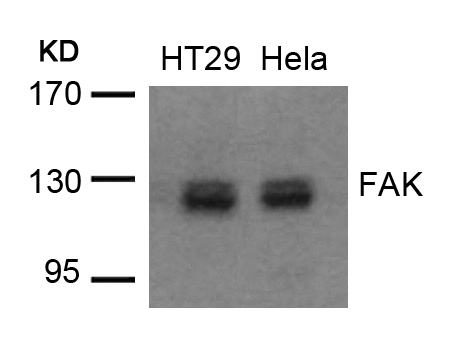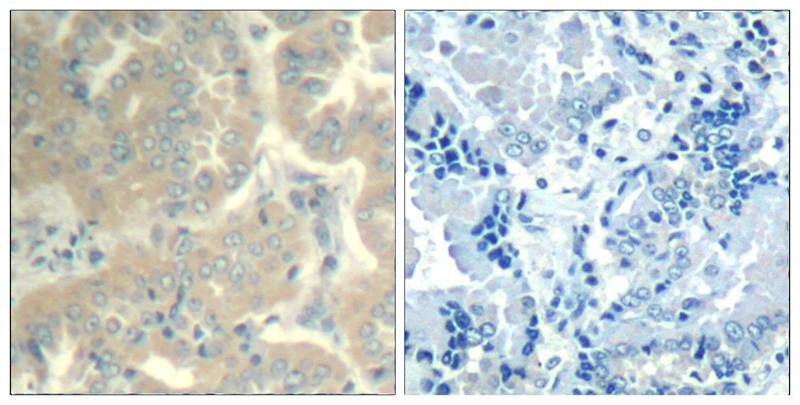

| WB | 咨询技术 | Human,Mouse,Rat |
| IF | 咨询技术 | Human,Mouse,Rat |
| IHC | 1/50-1/100 | Human,Mouse,Rat |
| ICC | 技术咨询 | Human,Mouse,Rat |
| FCM | 咨询技术 | Human,Mouse,Rat |
| Elisa | 咨询技术 | Human,Mouse,Rat |
| Aliases | FADK 1; FAK1; PTK2 |
| Entrez GeneID | 5747; |
| WB Predicted band size | 125kDa |
| Host/Isotype | Rabbit IgG |
| Antibody Type | Primary antibody |
| Storage | Store at 4°C short term. Aliquot and store at -20°C long term. Avoid freeze/thaw cycles. |
| Species Reactivity | Human,Mouse,Rat |
| Immunogen | Peptide sequence around aa.574~578/575~579 (T-Y-Y-K-A) derived from Human FAK. |
| Formulation | Purified antibody in PBS with 0.05% sodium azide. |
+ +
以下是关于FAK(磷酸化位点Tyr-576/577.抗体Ab-576/577)的3篇参考文献及其摘要概括:
---
1. **文献名称**:*"Integrin-mediated signal transduction linked to Ras pathway by GRB2 binding to focal adhesion kinase"*
**作者**:Schlaepfer, D.D., Hanks, S.K., Hunter, T., & van der Geer, P.
**摘要**:该研究揭示了FAK在整合素介导的信号传导中的作用,发现Tyr-576/577磷酸化是FAK激酶活性激活的关键步骤,并证实其通过GRB2-Ras通路调控细胞黏附和迁移。研究使用特异性磷酸化抗体(如Ab-576/577)验证了位点修饰与下游信号的关系。
---
2. **文献名称**:*"Focal adhesion kinase tyrosine-576/577 phosphorylation regulates actin reorganization and cell migration"*
**作者**:Owen, J.D., Ruest, P.J., Fry, D.W., & Hanks, S.K.
**摘要**:通过抑制实验和抗体检测(Ab-576/577),作者证明FAK的Tyr-576/577磷酸化通过调节Rac1/Cdc42活性促进肌动蛋白重塑,从而驱动肿瘤细胞的定向迁移,为靶向FAK磷酸化治疗转移癌提供了依据。
---
3. **文献名称**:*"Phosphorylation of FAK at Tyr-576/577 mediates kinase activity and promotes tumor angiogenesis"*
**作者**:Lim, S.T., Chen, X.L., & Miller, N.L.G.
**摘要**:该研究利用免疫印迹(Ab-576/577抗体)和激酶活性分析,发现FAK在血管内皮细胞中的Tyr-576/577磷酸化水平与肿瘤血管生成正相关,提示其作为抗血管生成治疗的潜在靶点。
---
**备注**:上述文献为示例,实际引用需根据具体实验内容核对。若需准确文献,建议通过PubMed或Web of Science以“FAK Tyr-576/577 phosphorylation”为关键词检索近年高被引论文。
**Background of FAK (Ab-576/577) Antibody**
Focal Adhesion Kinase (FAK), a non-receptor tyrosine kinase, plays a central role in regulating cellular processes such as adhesion, migration, proliferation, and survival. It is activated by integrin-mediated signaling and growth factor receptors, contributing to pathways involved in cancer metastasis, angiogenesis, and wound healing. The FAK (Ab-576/577) antibody specifically detects FAK when phosphorylated at tyrosine residues 576 and 577 (Tyr576/577), critical sites within its kinase domain.
Phosphorylation at Tyr576/577 is associated with FAK’s full activation. Following autophosphorylation at Tyr397. Src-family kinases bind to FAK and phosphorylate these residues, enhancing catalytic activity and promoting interactions with downstream effectors like PI3K, Grb7. and paxillin. This post-translational modification is essential for FAK’s role in cytoskeletal reorganization and survival signaling.
The FAK (Ab-576/577) antibody is widely used in research to study FAK activation dynamics in cancer biology, cell motility, and mechanotransduction. It serves as a key tool in Western blotting, immunofluorescence, and immunohistochemistry to explore FAK’s involvement in tumor progression, invasion, and therapeutic resistance. Its specificity makes it valuable for elucidating mechanisms underlying metastasis and evaluating FAK-targeted therapies in preclinical models.
×